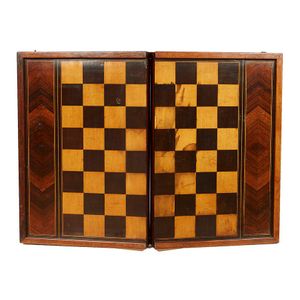Stained Walnut and Beech Coffer with Carved Decoration
You must be a subscriber, and be logged in to view price and dealer details.
Subscribe Now to view actual auction price for this item
When you subscribe, you have the option of setting the currency in which to display prices to $Au, $US, $NZ or Stg.
- Paw Feet - A paw foot is a base of a furniture leg that resembles the paw of an animal, such as a lion or bear. It is a decorative feature that is often seen in traditional furniture designs, particularly in styles such as Chippendale, Queen Anne, and Georgian. A paw foot typically consists of a carved or moulded ball or disk at the bottom of the leg, which is then carved or shaped to resemble the toes or claws of an animal. The foot may be smooth or textured, depending on the design, and may be finished in a variety of materials, such as wood, metal, or even marble.
Paw feet are often used on heavier pieces of furniture, such as chests, tables, and chairs, to provide additional stability and support. They are also used as a decorative element, adding a touch of elegance and sophistication to the overall design.
"Hairy paw feet" is a term used to describe a variation of the foot design that features a carved or sculpted animal paw, such as a lion or bear, with hair or fur details. The hair or fur details were often carved in a realistic manner and added to the overall decorative effect of the furniture. Hairy paw feet were commonly found on furniture items such as tables, chairs, and cabinets and were popular in the 18th century. - Beech - Beech, a pale coloured timber, is native to temperate Europe, Asia and North America and classified as a hardwood, although comparitively "soft" when compared with oak or ash. It has long been popular with with country craftsmen, particulary chair makers, as unlike ash it is suitable for turning.
This item has been included into following indexes:
Visually similar items

A French walnut backgammon set with various fruitwood Veneers, circa 1900. 12 cm high, 35.5 cm deep, 52.5 cm wide (closed)

An Australian Arts & Crafts fire screen with carved wedgedtail eagle and Waratahs, New South Wales origin, circa 1900, 87 cm high, 56 cm wide

Two Georgian needlework pictures on silk, early 19th century, one depicting a boy with dog, the other a girl fetching water, both framed in original gilt frames and mounted on board, 44 cm x 31 cm, and 45 cm x 31 cm retrospectively

A marble topped cast iron Conservatory table; the rectangular top on a Singer sewing machine base. Width 90 cm
